Answer to previous issue’s “What the … ?”
I challenged y’all to identify a critter in the last issue of this newsletter. Okay, a “critter” is perhaps not the best description for the weird growth depicted in S. Stewart’s pictures.
The weird growth stumped me, but it didn’t stump many of you! More than 85% of you! Thanks to y’all who answered the challenge and provided the correct diagnosis: Bob Anderson, Jeff Batch, Tommy Bojsen, Jim Borland, Kathleen Bridges, Claude Chalifour, Mike Craib, Megan Davis, Mark Denee, Heidi Doering, Ellen Egan, Beth Engle, Brian Eshenaur, Kathleen Glasman, Albert Grimm, Dan Heims, Royal Heins, Larry Hurley, Debra Knapke, Kathy Larson … Okay, let me take a breath … Daniel Lee, Kim Moyer, Natasha Park, Joe Parr, Ron Rabideau, Giorgio Rampinini, Scott Sauer, Biene Schaefer, Bobbie Schwartz, Ted Stephens, Carolyn Thomas, Carl van Staalduinen, Virginia White, Stew Winchester, and Elise Zylstra. Giles van Hees won first place by sending in a correct answer within minutes of receiving the newsletter. And, missing the first place by just a couple of minutes was GrowerTalks’ very own Chris Beytes and Sandy Feather of PennState Extension.
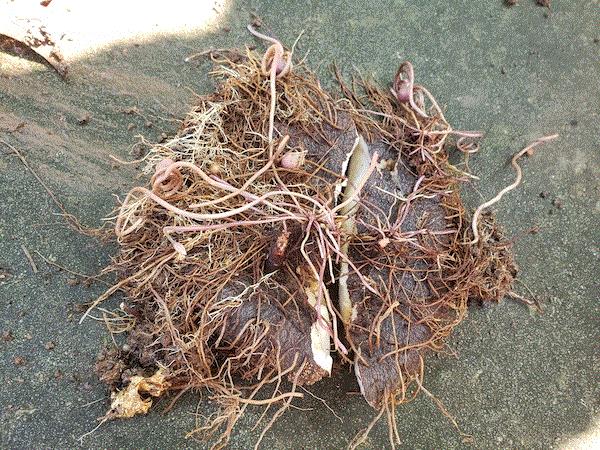
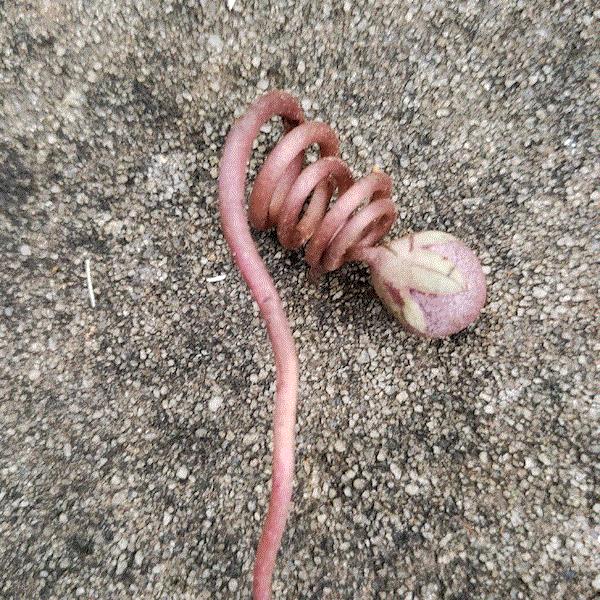
The mushroom-like weird growth is the corm of a hardy cyclamen, and the bulb on top of the curly stalk is the seed pod. Not entirely sure of the species, but Megan from Seattle suggested that I identify the species by its bloom time. Since S. saw flowers in the spring, I assume this is Cyclamen coum. If it flowers in late summer or fall, then it may be Cyclamen hederifolium. In addition to acquiring the skill of identifying two hardy cyclamen species by bloom time, I also learnt a couple of cool facts about them.
Did you know that the seed pods actually curl down to the ground before they open? I didn’t know that, but Brian Eshenaur of Cornell’s IPM Program did. Brian told me that cyclamen seed pods open closer to the ground to help ants harvest the seeds. Cyclamen seeds are coated with elaiosome—a layer of “flesh” composed of fats and proteins that is irresistible to ants. Ants harvest elaiosome along with the seeds and take them back to their nests. Ants eat the elaiosome and dump the seeds on the outside of the nest. By giving away a little bit of its “candy,” cyclamen recruits ants to disperse its seeds. This mutualistic relationship is called myrmecochory, which isn’t unique to cyclamen and ants. John Bickel of the Scott Arboretum of Swarthmore College wrote a great piece about myrmecochory in cyclamen; read it by clicking here.
Albert Grimm, head grower of Jeffery’s Greenhouse in St. Catherines, Ontario, provided the second piece of new knowledge. Most hardy cyclamen species originate from the alpine regions of central and southeastern Europe; this, many of us know. But, did you know that many species are endangered and are, therefore, subjected to CITES (Convention on International Trade in Endangered Species) regulations? I’m sure S. isn’t breaking any law since her cyclamen is likely a cultivated variety. But, if you are interested in finding out which cyclamen species are under CITES regulations, click here.
Many of you also noted the size of the corm. S. guessed that the cyclamen were planted perhaps soon after the house was built 20 years ago. Albert commented that a corm of this size could definitely be a collectible. Now, I’ve heard of a lot of different plant collectors (or crazies?) so it wouldn't surprise me if someone actually collects large cyclamen corms. All the more reason I won't tell you where S. lives.

What the … ? Bug in a cage edition
I think many folks in (and outside) my family received a memo last week telling them to send me pictures of bugs in (some sort of) cages for identification. I’ll share a collection of three.
The first one came courtesy of my mother-in-law, with a picture taken by my lovely wife showing a robber fly caught in a plastic cup. My first thought was, “Hey, that’s a plastic cup we used to serve white wine at the annual art show!” I’m the bartender at the show so I’m a bit protective of resources allocated to me. Anyway, the elongated and colorful robber flies are pretty common; they often zip by with insect prey in tow. They catch insects of all kinds in the air, and suck them dry on their perches. Larvae live in the soil, also as predators. University of Florida has a nice factsheet about them; click here.
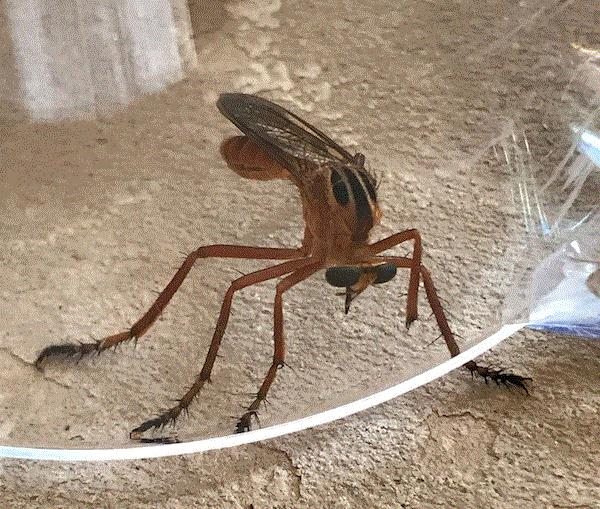
Since it wasn’t a super-sized blood-sucking mosquito, but a beneficial insect-killing machine, this robber fly was released to resume its reign of terror in the sky.
Speaking of terror in the sky, avid golfers among you perhaps have seen this next creature. Super-sized black and yellow wasps flying by threateningly, just as you are ready to tee-off. (Yes, I totally believe that’s precisely why you didn't play like Jack or Tiger that day.)
Gerrit van Vulpen sent the picture of a cicada killer wasp caught in a … plastic fish tank? When I identified the large, one-to-two-inch long wasp as the cicada killer, Gerrit said, “Interesting. That’s exactly where I found it, carrying a cicada.” This is not the first inquiry I received about cicada killers this week. Other requests specifically asked for how to control them on golf courses because golfers are wary of the large wasps. Tennis racquets work well against them, but apparently golf clubs do not.
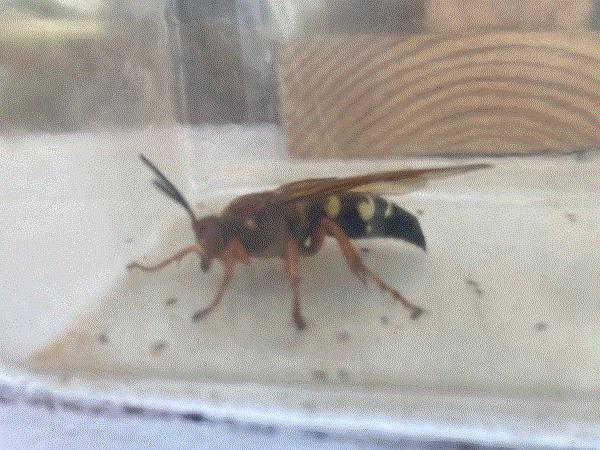
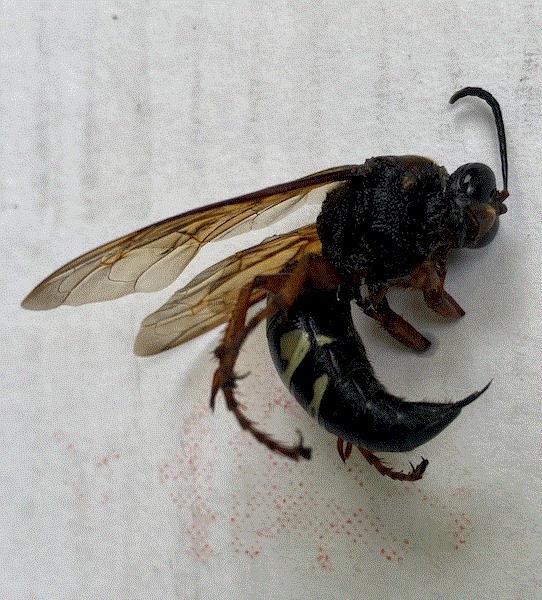
The cicada killers are actually quite interesting. Females find and capture cicadas, sting and paralyze them, then carry the cicadas back to their underground lairs. The second picture shows you the same wasp, with the stinger on full display; I can’t imagine how it would’ve felt to be stung. A cicada killer carrying a cicada that’s twice her own size back to the nest is a sight to see. Once she gathers enough cicadas in the nest, she will lay eggs on the cicadas. Remember that these cicadas are only paralyzed, so they’re still alive when the wasp larvae begin feeding on them. A good way to keep the meat fresh, I guess. Do I want to feel like a cicada facing my worst enemy? NO THANK YOU!
The cicada killer builds an elevated “takeoff ramp” right outside of the nest entrance to help land (with a cicada) or take off. I usually discourage killing them because the wasps, although scary, are generally harmless unless they are threatened. If a client really wants to kill the wasps to protect themselves or their pets, I usually recommend sprinkling Sevin powder or spraying pyrethroid solution on the takeoff ramp. Wasps will die after contacting the insecticide residue on the path.
The third bug in a cage is from my wife’s stepmom. This one was a stink bug collected from tomato and kept in a Ziplock bag. It actually took me a while to identify the stink bug as the twice-stabbed stink bug. Guess why it’s called “twice-stabbed.” Although it’s widespread geographically in North America, it’s not a commonly seen species. (At least not common to me.) I’ve never seen them on tomatoes, but I assume they can be controlled just like any stink bug on tomatoes in a home vegetable garden—with a pair of quick hands and a bucket of soapy water.
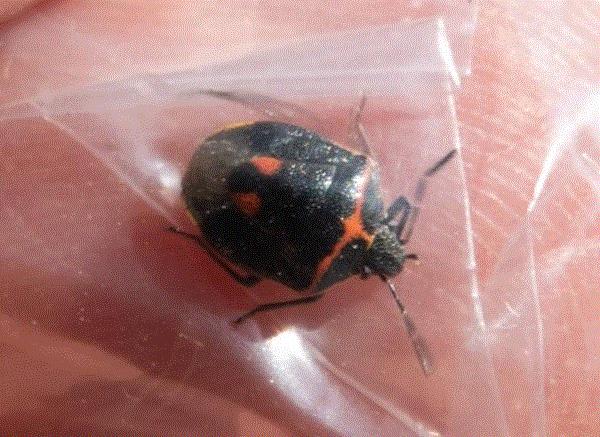

Segway O now labeled for veggies and herbs
OHP has announced that Segway O, which contains cyazofamid (FRAC Group 21), has expanded its label to include uses on greenhouse-grown tomato transplants, bell pepper and many members of the Herb Crop Subgroup 19A. Segway O is labeled for the management of pythium, phytophthora and downy mildew via soil drench and spray. Cyazofamid is currently the only product within Group 21, so it's a valuable tool for fungicide rotation programs, particularly against resistant pythium and phytothphora populations in greenhouses and nurseries. Rotate Segway O with other fungicides to reduce the risk of fungicide resistance development in pythium and phytophthora.
Click here for more information about Segway O.

Bayer introduces pest identification guide in Spanish
Bayer Environmental Science released a Pest Identification Guide for Greenhouses and Nurseries last week. The guide is full of color pictures and short descriptions of the pest, the host plants and suitable Bayer products, which will be helpful in identifying and managing common insects, weeds and diseases in nurseries and greenhouses.
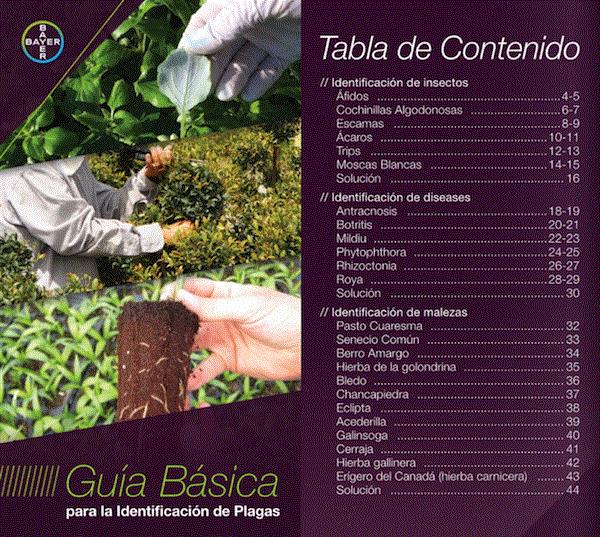
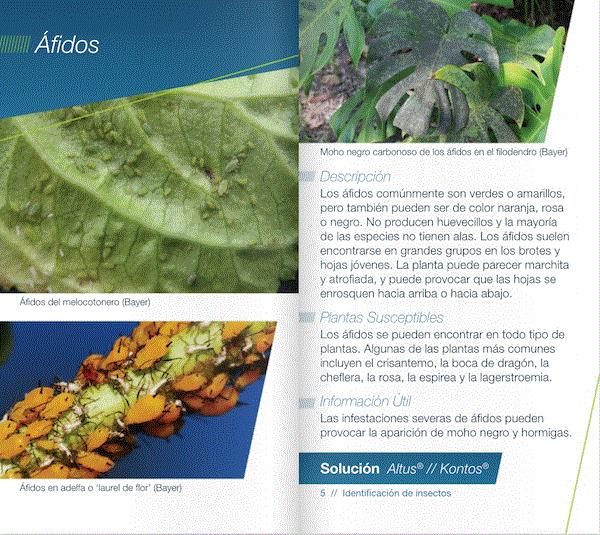
The guide is available in Spanish and English, but Bayer emphasizes the usefulness of this guide to Spanish-speaking workers. When visiting different operations, I often preach the importance of giving Spanish-speaking workers the best training and resources possible because they are on the front lines and can detect pest infestation sooner than anyone on the production team. This guide can help them identify pests, weeds and diseases, and communicate their findings more effectively to growers. This effective communication will allow the growers to design an effective management program sooner.
Free digital versions, in Spanish and English, are available by clicking here. Pocket-sized, scratch-resistant, spiral-bound hard copies can be ordered (for a fee) from the same website.

Tech on Demand podcast is available

Tech On Demand is an interview-style podcast hosted by GrowerTalks Senior Editor, Bill Calkins. Bill interviews green industry experts from around the world to give you technical and cultural information to grow the best crop. Four timely podcasts are now available. Bill talked to Aaron Palmateer of Bayer on managing insects and diseases of poinsettia, Todd Cavins of Ball Horticultural on greenhouse sanitation, and Jerry Gorchels of PanAmerican Seed, Gary Vollmer of Ball FloraPlant and Selecta One, and Chris Fifo of Darwin Perennials and Kieft Seed on holding and delaying greenhouse crops.
This podcast is now available on Apple Podcasts, Spotify, TuneIn, Podbean, Sitcher and other major podcast players. You can listen and subscribe to the podcast by clicking here.
See y'all next time!

JC Chong
Professor of Entomology at Clemson University
This e-mail received by 23,162 subscribers like you!
If you're interested in advertising on PestTalks contact Kim Brown ASAP!